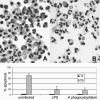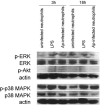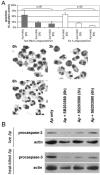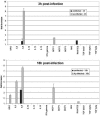Anaplasma phagocytophilum delay of neutrophil apoptosis through the p38 mitogen-activated protein kinase signal pathway
- PMID: 16299317
- PMCID: PMC1307085
- DOI: 10.1128/IAI.73.12.8209-8218.2005
Anaplasma phagocytophilum delay of neutrophil apoptosis through the p38 mitogen-activated protein kinase signal pathway
Abstract
Human granulocytic anaplasmosis is caused by the obligate intracellular bacterium Anaplasma phagocytophilum. The bacterium avoids host innate defenses in part by infecting, surviving in, and propagating in neutrophils, as well as by inhibiting neutrophil apoptosis. However, the mechanisms of A. phagocytophilum survival in neutrophils and the inhibition of spontaneous apoptosis are not well understood. In this study, we demonstrated that antiapoptotic Mcl-1 protein (Bcl-2 family) expression is maintained and that inhibition of procaspase-3 processing occurs in A. phagocytophilum-infected human neutrophils. An evaluation of p38 mitogen-activated protein kinase (MAPK) showed evidence of increased phosphorylation with infection. Moreover, antagonism of p38 MAPK by the inhibitor SB203580 reversed apoptosis inhibition in live or heat-killed A. phagocytophilum-infected neutrophils. A role for the autocrine or paracrine production of antiapoptotic interleukin 8 (IL-8) expressed with A. phagocytophilum infection was excluded by the use of IL-8-, IL-8R1 (CXCR1)-, and IL-8R2 (CXCR2)-blocking antibodies. As previously demonstrated, the antiapoptotic effect was initially mediated by exposure to A. phagocytophilum components in heat-killed bacteria. However, an important role for active infection is demonstrated by the additional delay in apoptosis with intracellular growth and the refractory abrogation of this response by the p38 MAPK inhibitor 3 to 6 h after neutrophil infection. These results suggest that the initial activation of the p38 MAPK pathway leading to A. phagocytophilum-delayed neutrophil apoptosis is bypassed with active intracellular infection. Moreover, active intracellular infection contributes more to the overall delay in apoptosis than do components of heat-killed A. phagocytophilum alone.
Figures







References
-
- Aga, E., D. M. Katschinski, G. van Zandbergen, H. Laufs, B. Hansen, K. Muller, W. Solbach, and T. Laskay. 2002. Inhibition of the spontaneous apoptosis of neutrophil granulocytes by the intracellular parasite Leishmania major. J. Immunol. 169:898-905. - PubMed
-
- Akgul, C., D. A. Moulding, and S. W. Edwards. 2001. Molecular control of neutrophil apoptosis. FEBS Lett. 487:318-322. - PubMed
-
- Alvarado-Kristensson, M., M. I. Porn-Ares, S. Grethe, D. Smith, L. Zheng, and T. Andersson. 2002. p38 mitogen-activated protein kinase and phosphatidylinositol 3-kinase activities have opposite effects on human neutrophil apoptosis. FASEB J. 16:129-131. - PubMed
-
- Aoshiba, K., S. Yasui, M. Hayashi, J. Tamaoki, and A. Nagai. 1999. Role of p38-mitogen-activated protein kinase in spontaneous apoptosis of human neutrophils. J. Immunol. 162:1692-1700. - PubMed
Publication types
MeSH terms
Substances
Grants and funding
LinkOut - more resources
Full Text Sources
Research Materials

